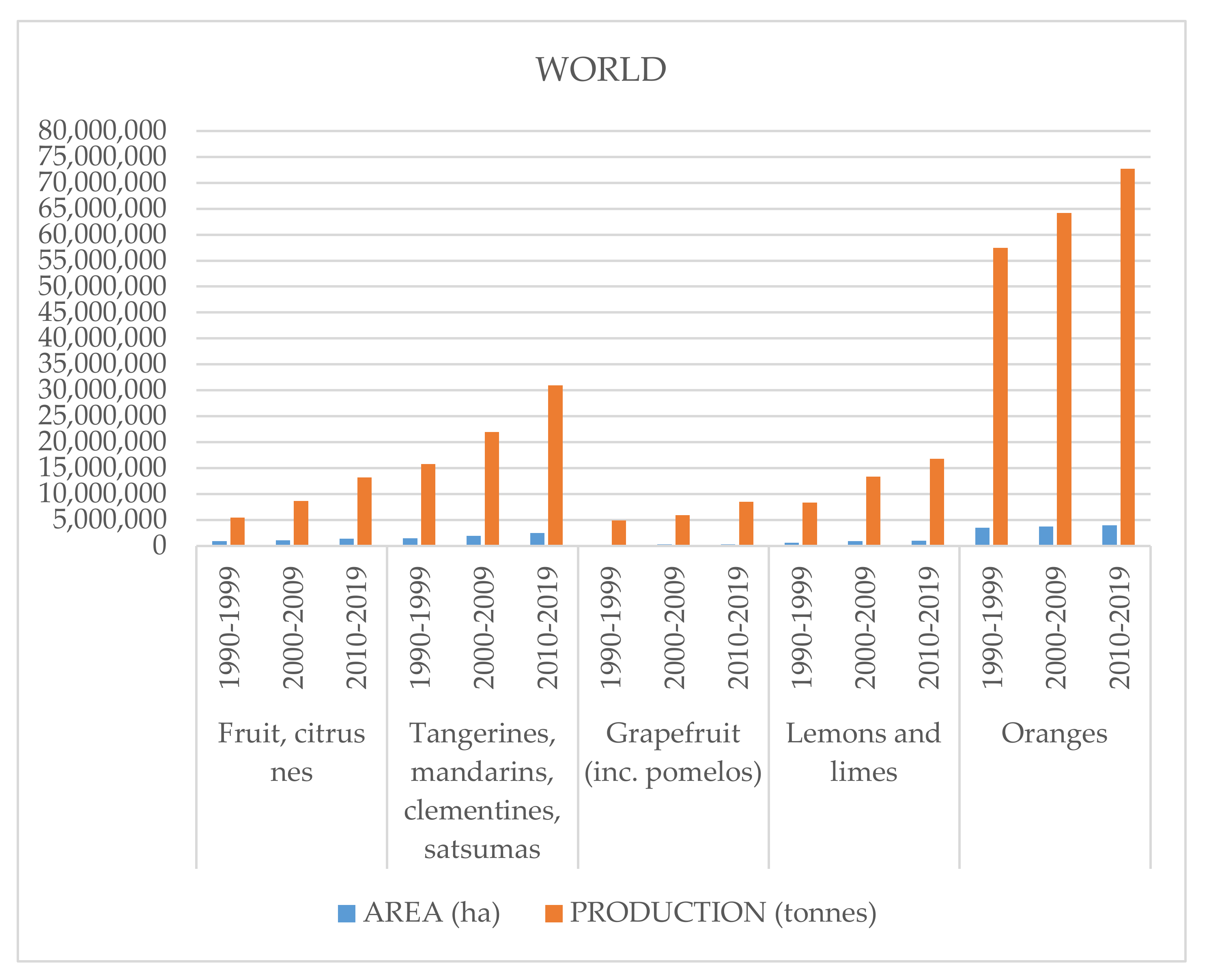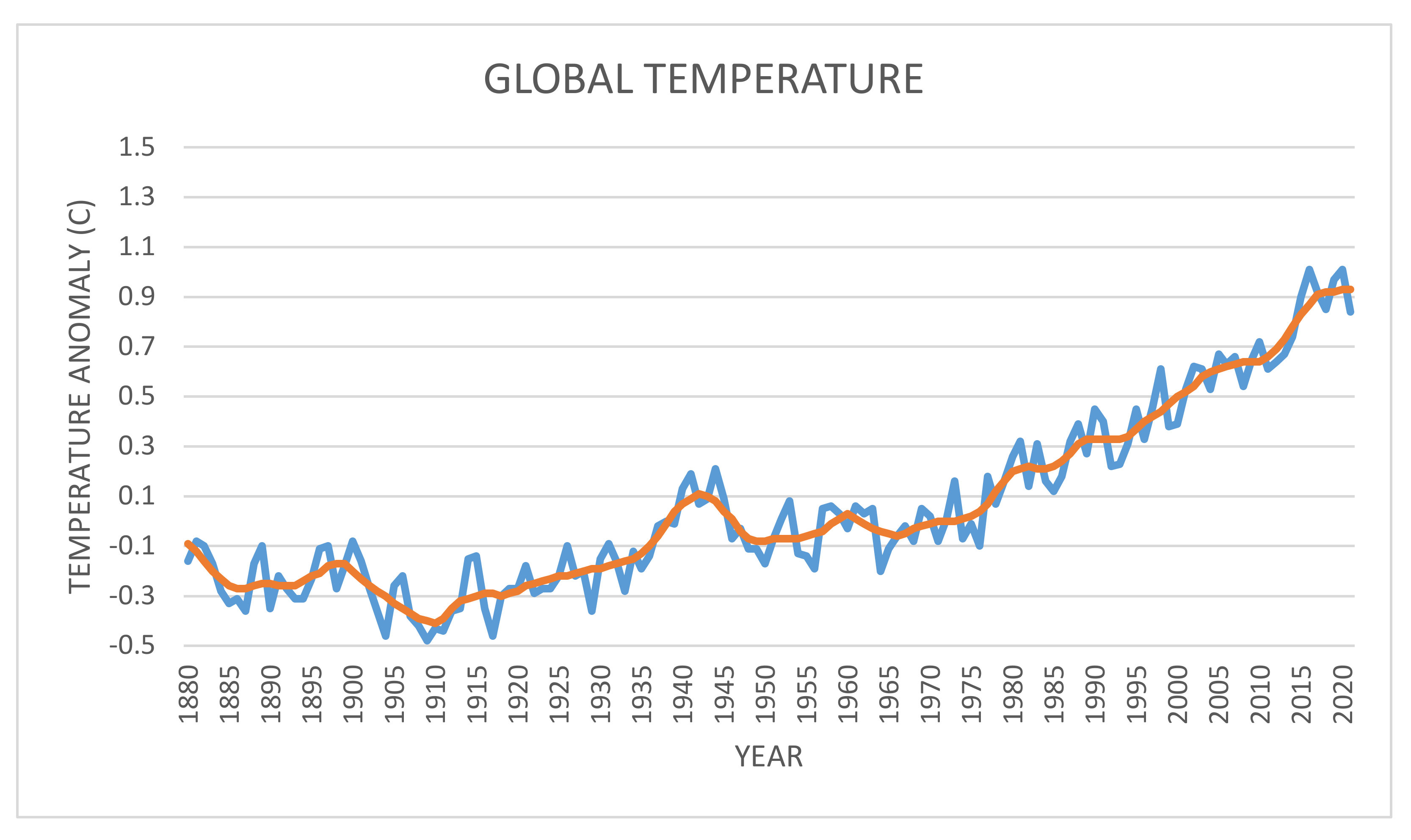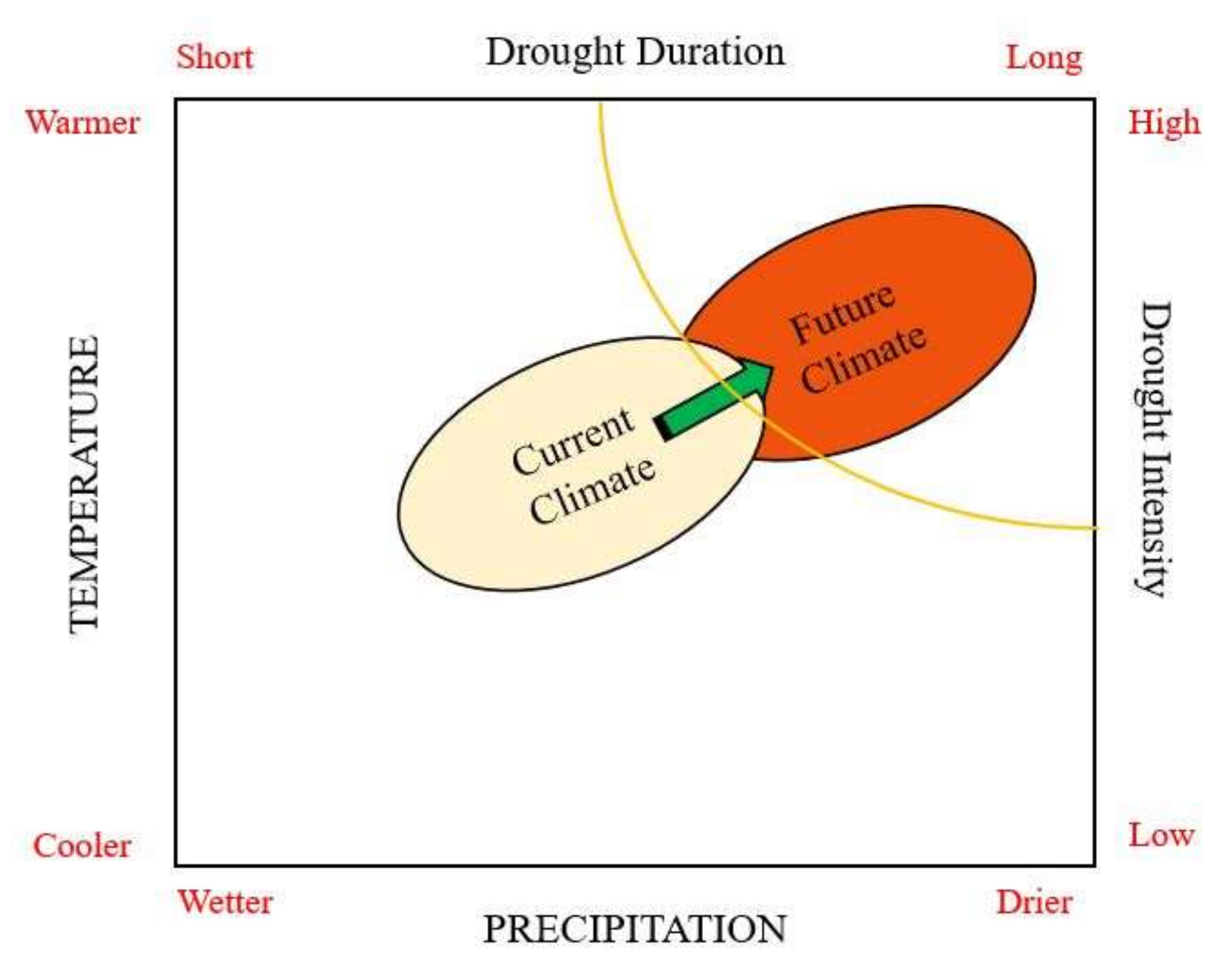Multi-Criteria Analysis of Investment Choices Following Flood Damage: The Case Study of Sustainable Citrus Farming in Sicily
Abstract
:1. Introduction
2. Materials and Methods
2.1. Overview of Citrus Farming and the Main Investment needs Resulting from Structural Damage
2.2. Climate Change and Agricultural Production
2.3. Methodology
- The intensity index μ*(a,b) has the following characteristics:
- ≤ μ*(a,b) ≤1;
- μ*(a,b) = 0 if none of the μ*(a,b)_m are more than α;
- μ*(a,b) = 1 if μ*(a,b)_m ≥ α ∀ m and μ*(a,b)_m > α for at least one criterion.
- a is better than b;
- a and b are the same;
- a is worse than b.
3. Results
- (a)
- Economic goal: Production, Prices, Gross Saleable Production (GSP), Variable Production Costs, Production Costs, Gross Income, Net Income, Productivity in the presence of damage, Cost of the action strategy to support the affected citrus groves;
- (b)
- Socio-environmental goal: Number of employees, Labour risk, Degrees of activity;
- (c)
- Phytosanitary goal: disease detection, definition of the citrus orchard’s useful life, disease management.
4. Discussion
5. Conclusions
Author Contributions
Funding
Institutional Review Board Statement
Informed Consent Statement
Data Availability Statement
Conflicts of Interest
References
- Mogues, T.; Fan, S.; Benin, S. Public Investments in and for Agriculture. Eur. J. Dev. Res. 2015, 27, 337–352. [Google Scholar] [CrossRef]
- DeLonge, M.S.; Miles, A.; Carlisle, L. Investing in the transition to sustainable agriculture. Environ. Sci. Policy 2016, 55, 266–273. [Google Scholar] [CrossRef] [Green Version]
- De Marchi, B.; Funtowicz, S.O.; Lo Cascio, S.; Munda, G. Combining participative and institutional approaches with multicriteria evaluation. An empirical study for water issues in Troina, Sicily. Ecol. Econ. 2000, 34, 267–282. [Google Scholar] [CrossRef]
- Gooday, R.D.; Anthony, S.G.; Chadwick, D.R.; Newell-Price, P.; Harris, D.; Duethmann, D.; Fish, R.; Collins, A.L.; Winter, M. Modelling the cost-effectiveness of mitigation methods for multiple pollutants at farm scale. Sci. Total Environ. 2014, 468–469, 1198–1209. [Google Scholar] [CrossRef] [PubMed]
- Ramakumar, R. Large-scale Investments in Agriculture in India. IDS Bull. 2012, 43, 92–103. [Google Scholar] [CrossRef] [Green Version]
- Ziemba, P. Uncertain Multi-Criteria analysis of offshore wind farms projects investments—Case study of the Polish Economic Zone of the Baltic Sea. Appl. Energy 2022, 309, 118232. [Google Scholar] [CrossRef]
- Nijkamp, P.; van Delf, A. Multi-Criteria Analysis and Regional Decision Making; Springer Science & Business Media: Leiden, The Netherlands, 1977. [Google Scholar]
- Munaretto, S.; Siciliano, G.; Turvani, M. Integrating adaptive governance and participatory multicriteria methods: A framework for climate adaptation governance. Ecol. Soc. 2014, 19, 74. [Google Scholar] [CrossRef] [Green Version]
- Sturiale, L.; Scuderi, A.; Timpanaro, G.; Matarazzo, B. Sustainable use and conservation of the environmental resources of the etna park (unesco heritage): Evaluation model supporting sustainable local development strategies. Sustainability 2020, 12, 1453. [Google Scholar] [CrossRef] [Green Version]
- Scuderi, A.; Pecorino, B. Protected Designation of Origin (PDO) and Protected Geographical Indication (PGI) Italian citrus productions. Acta Hortic. 2015, 1065, 1911–1917. [Google Scholar] [CrossRef]
- Carrà, G.; Peri, I.; Scuderi, A. Euro-mediterranean agricultural trade agreement:which real impact on the EU citrus production? Qual.—Access Success 2014, 14, 111–116. [Google Scholar]
- Scuderi, A.; D’Amico, M. Evolution of development models of Italian organic citrus. Acta Hortic. 2015, 1065, 1877–1888. [Google Scholar] [CrossRef]
- Chinnici, G.; Pecorino, B.; Scuderi, A. Enviromental and economic performance of organic citrus growing. Qual.—Access Success 2013, 13, 7. [Google Scholar]
- Hwang, C.L.; Yoon, K. Multi Attribute Decision Making: Methods and Applications; Springer: Berlin/Heidelberg, Germany, 1981. [Google Scholar]
- Scuderi, A.; Sturiale, L. Multi-criteria evaluation model to face phytosanitary emergiences: The case of citrus fruits farming in Italy. Agric. Econ. 2016, 65, 205–214. [Google Scholar]
- Herva, M.; Roca, E. Review of combined approaches and multi-criteria analysis for corporate environmental evaluation. J. Clean. Prod. 2013, 39, 355–371. [Google Scholar] [CrossRef]
- Prisenk, J.; Turk, J.; Rozman, C.; Borec, A.; Zrakic, M.; Pazek, K. Advantages of combining linear programming and weighted goal programming for agriculture application. Int. J. Oper. Res. 2014, 14, 253–260. [Google Scholar] [CrossRef]
- Xavier, A.; de Belém Costa Freitas, M.; Fragoso, R.; do Socorro Rosário, M. A regional composite indicator for analysing agricultural sustainability in Portugal: A goal programming approach. Ecol. Indic. 2018, 89, 84–100. [Google Scholar] [CrossRef]
- FAO. Faostat Data. 2021. Available online: http://fenix.fao.org/faostat/internal/en/#home (accessed on 2 April 2022).
- ISTAT. Annuario di Statistica. Roma. 2021. Available online: https://www.istat.it/storage/ASI/2021/ASI_2021.pdf (accessed on 23 April 2022).
- Heather and Hallman. Pest Management and Phytosanitary Trade Barriers; CABI Head Office: Oxfordshire, UK, 2008. [Google Scholar]
- Timpanaro, G.; Cammarata, M.; Urso, A. Analysis of Trade Flows of Ornamental Citrus Fruits and Other Rutaceae in the Mediterranean Basin and Potential for Xantomonas citri Introduction. Agriculture 2020, 10, 171. [Google Scholar] [CrossRef]
- Scuderi, A.; Zarbà, A.S. Economic analysis citrus fruit destined to market. Ital. J. Food Sci. 2011, 23, 34–37. [Google Scholar]
- Basile, F.; Foti, V.T.; Timpanaro, G. Comparative economic analyses between conventional and ecocompatible cactus pear cultivation in Italy. Acta Hortic. 2002, 581, 47–61. [Google Scholar] [CrossRef]
- Davino, S.; Willemsen, A.; Panno, M.; Catara, A.; Elena, S.F.; Rubio, L. Emergence and Phylodynamics of Citrus tristeza virus in Sicily, Italy. PLoS ONE 2013, 8, e66700. [Google Scholar] [CrossRef] [Green Version]
- Foti, V.T.; Scuderi, A.; Stella, G.; Sturiale, L.; Timpanaro, G.; Trovato, M.R. The Integration of Agriculture in the Politics of Social Regeneration of Degraded Urban Areas. In Integrated Evaluation for the Management of Contemporary Cities SIEV 2016; Green Energy and Technology; Mondini, G., Fattinnanzi, E., Oppio, A., Bottero, M., Stanghellini, S., Eds.; Springer: Berlin, Germany, 2018. [Google Scholar]
- Pareek, A.; Dhankher, O.M.; Foyer, C. Mitigating the impact of climate change on plant productivity and ecosystem sustainability. J. Exp. Bot. 2020, 71, 451–456. [Google Scholar] [CrossRef]
- Kan, I.; Ayal, K.; Jonathan, K. The Impact of Climate Change on the Agriculture and Food Prices: Combinig a Micro Land Use Model and a Market Equilib-rium Model. In Proceedings of the 2014 International Congress, Ljubljana, Slovenia, 26–29 August 2014; European Association of Agricultural Economists: Gelderland, The Netherlands; p. 183024. [Google Scholar]
- Hawkins, E.; Ortega, P.; Suckling, E.; Schurer, A.; Hegerl, G.; Jones, P.; Joshi, M.; Osborn, T.J.; Masson-delmotte, V.; Mignot, J.; et al. Estimating Changes in Global Temperature since the Preindustrial Period. Bull. Am. Meteorol. Soc. 2017, 98, 1841–1856. [Google Scholar] [CrossRef]
- European Commission. The European Green Deal. Brussels, 11.12.2019 COM(2019) 640 Final. 2019. Available online: https://eur-lex.europa.eu/resource.html?uri=cellar:b828d165-1c22-11ea-8c1f-01aa75ed71a1.0002.02/DOC_1&format=PDF (accessed on 13 May 2022).
- Intergovernmental Panel on Climate Change. Climate Change 2022 Impacts, Adaptation and Vulnerability. IPCC WGII Sixth Assessment Report. 2022. Available online: https://www.ipcc.ch/report/ar6/wg2/downloads/report/IPCC_AR6_WGII_FinalDraft_FullReport.pdf (accessed on 26 May 2022).
- Georgopoulou, E.; Mirasgedis, S.; Sarafidis, Y.; Vitaliotou, M.; Lalas, D.P.; Theloudis, I.; Giannoulaki, K.D.; Dimopoulos, D.; Zavras, V. Climate change impacts and adaptation options for the Greek agriculture in 2021–2050: A monetary assessment. Clim. Risk Manag. 2017, 16, 164–182. [Google Scholar] [CrossRef]
- Panagos, P.; Standardi, G.; Borrelli, G.; Lugato, E.; Montanarella, L.; Bosello, F. Cost of agricultural productivity loss due to soil erosion in theEuropean Union: From direct cost evaluation approaches to theuse of macroeconomic models. Land Degrad. Dev. 2018, 29, 471–484. [Google Scholar] [CrossRef]
- Munda, G. A NAIADE based approach for sustainability benchmarking. Int. J. Environ. Technol. 2006, 6, 65–78. [Google Scholar] [CrossRef]
- Krueger, R.A.; Casey, M.A. Focus Group Interviewing Chapter 20. In Handbook of Practical Program Evaluation; Kathryn, E., Harry, P., Joseph, S., Eds.; Wholey John Wiley & Sons Incorporated: Hoboken, NJ, USA, 2015. [Google Scholar]
- Israel, G.D.; Galindo-Gonzalez, S. Using Focus Group Interviews for Planning or Evaluating Extension Programs; Institute of Food and Agricultural Sciences, University of Florida: Gainesville, FL, USA, 2008. [Google Scholar]
- Munda, G.; Nijkamp, P.; Rietveld, P. Qualitative multicriteria evaluation for environmental management. Ecol. Econ. 1994, 10, 97–112. [Google Scholar] [CrossRef]
- Munda, G. Social multi-criteria evaluation (SMCE): Methodological foundations and operational consequences. Eur. J. Oper. Res. 2004, 158, 662–677. [Google Scholar] [CrossRef]
- Arru, B.; Furesi, R.; Madau, F.A.; Pulina, P. Economic performance of agritourism: An analysis of farms located in a less favoured area in Italy. Agric. Food Econ. 2021, 9, 27. [Google Scholar] [CrossRef]
- Melo, W.; Delarica, D.; Guedes, A.; Lavezzo, L.; Donha, R.; Araújo, A.; de Melo, G.; Macedoa, F. Ten years of application of sewage sludge on tropical soil. A balance sheet on agricultural crops and environmental quality. Sci. Total Environ. 2018, 643, 1493–1501. [Google Scholar] [CrossRef] [PubMed] [Green Version]
- Ogilvy, S. Developing the ecological balance sheet for agricultural sustainability. Sustain. Account. Manag. Policy J. 2015, 6, 110–137. [Google Scholar] [CrossRef]
- Campiglio, E.; Godin, A.; Kemp-Benedict, E. Networks of stranded assets: A case for a balance sheet approach. AFD Res. Pap. 2017, 54, 1–23. [Google Scholar]
- Bobryshev, A.N.; Uryadova, T.N.; Lyubenkova, E.P.; Yakovenko, V.S.; Alekseeva, O.A. Analytical and management approaches to modeling of the accounting balance sheet. Life Sci. 2014, 11, 502–506. [Google Scholar]
- Kabir, M.J.; Cramb, R.; Gaydon, D.S.; Roth, C.H. Bio-economic evaluation of cropping systems for saline coastal Bangladesh: II. Economic viability in historical and future environments. Agric. Syst. 2017, 155, 103–115. [Google Scholar] [CrossRef]
- Ebukiba, E. Economic analysis of cassava production (farming) in Akwa Ibom State. ABJNA 2010, 1, 612–614. [Google Scholar]
- Shin, S.; Eksioglu, B. An empirical study of RFID productivity in the U.S. retail supply chain. Int. J. Prod. Econ. 2015, 163, 89–96. [Google Scholar] [CrossRef]
- Arru, B.; Furesi, R.; Madau, F.A.; Pulina, P. Agritourism, Farm Income Differentiation, and Rural Development: The Case of the Region of Montiferru (Italy). In New Metropolitan Perspectives; Bevilacqua, C., Calabrò, F., Della Spina, L., Eds.; Springer: Cham, Switzerland, 2021; Volume 178. [Google Scholar]
- Atzori, A.S.; Furesi, R.; Madau, F.; Pulina, P. Sustainability of Dairy Sheep Production in Pasture Lands: A Case Study Approach to Integrate Economic and Environmental Perspectives. Riv. Studi Sulla Sostenibil. 2015, 2015, 117–134. [Google Scholar]
- Foti, V.T.; Scuderi, A.; Timpanaro, G. The economy of the common good: The expression of a new sustainable economic model. Qual. Access Success 2017, 18, 206–214. [Google Scholar]



| Evaluation Criteria | Hypothesis 1 | Hypothesis 2 | Hypothesis 3 |
|---|---|---|---|
| Economic | Excellent | Good | Poor |
| Social | Good | Very good | Very good |
| Phytosanitary | Excellent | Good | Poor |
| Stakeholder Groups/Scenarios | Hypothesis 1 | Hypothesis 2 | Hypothesis 3 |
|---|---|---|---|
| Producers | Excellent | Good | Good |
| Cooperatives | Excellent | Good | Poor |
| Traders | Excellent | Poor | Poor |
| Processing industries | Good | Very good | Excellent |
| Trade Unions | Very good | Very good | Good |
| Istitutions | Very good | Medium | Good |
| Scientific groups | Excellent | Poor | Poor |
| Tertiary companies | Excellent | Medium | Good |
| Evaluation Criteria | Hypothesis 1 | Hypothesis 2 | Hypothesis 3 |
|---|---|---|---|
| Economic | 0.79 | 0.67 | 0.56 |
| Production | 0.91 | 0.72 | 0.54 |
| Prices | 0.84 | 0.52 | 0.45 |
| GSP | 0.87 | 0.62 | 0.49 |
| Variable production costs (VC) | 0.87 | 0.74 | 0.61 |
| Total production costs | 0.82 | 0.69 | 0.57 |
| Gross income | 0.92 | 0.79 | 0.51 |
| Net income | 0.81 | 0.77 | 0.63 |
| Project costs | 0.31 | 0.57 | 0.75 |
| Social | 0.64 | 0.53 | 0.50 |
| Employees | 0.71 | 0.51 | 0.52 |
| Work specialisation | 0.87 | 0.52 | 0.39 |
| Activity levels | 0.34 | 0.58 | 0.61 |
| Sustainable use of irrigation | 0.93 | 0.56 | 0.47 |
| Phytosanitary | 0.90 | 0.48 | 0.36 |
| Absence of root diseases | 0.94 | 0.39 | 0.35 |
| Fewer plant protection measures | 0.87 | 0.69 | 0.38 |
| Useful life of the citrus grove in relation to diseases | 0.91 | 0.38 | 0.34 |
| Quality of production | 0.89 | 0.47 | 0.38 |
| Year | 1 | 2 | 3 | 4 | 5 | 6 | 7 | 8 | 9 | 10 |
|---|---|---|---|---|---|---|---|---|---|---|
| Production | 0 | 0 | 1000 | 4000 | 20,000 | 30,000 | 40,000 | 40,000 | 40,000 | 40,000 |
| Prices | 0.5 | 0.5 | 0.5 | 0.5 | 0.5 | 0.5 | 0.5 | 0.5 | 0.5 | 0.5 |
| GSP | 0 | 0 | 500 | 2000 | 10,000 | 15,000 | 20,000 | 20,000 | 20,000 | 20,000 |
| Variable costs | 3175 | 3493 | 3810 | 4128 | 4445 | 4763 | 4763 | 4763 | 4763 | 4763 |
| Gross income without reinstatement costs | −3175 | −3493 | −3310 | −2128 | 5554 | 10,236 | 15,236 | 15,236 | 15,236 | 15,236 |
| Standard plant costs over 10 years | 1215 | 1215 | 1215 | 1215 | 1215 | 1215 | 1215 | 1215 | 1215 | 1215 |
| Gross income | −4391 | −4708 | −4526 | −3343 | 4338 | 9021 | 14,021 | 14021 | 14,021 | 14,021 |
| Year | 1 | 2 | 3 | 4 | 5 | 6 | 7 | 8 | 9 | 10 |
|---|---|---|---|---|---|---|---|---|---|---|
| Production | 18,451 | 18,451 | 19,000 | 20,500 | 23,500 | 26,000 | 28,500 | 28,500 | 28,500 | 28,500 |
| Prices | 0.35 | 0.35 | 0.35 | 0.35 | 0.4 | 0.4 | 0.45 | 0.45 | 0.45 | 0.45 |
| GSP | 6457 | 6457 | 6650 | 7175 | 9400 | 10,400 | 12,825 | 12,825 | 12,825 | 12,825 |
| Variable costs | 6258 | 5006 | 5131 | 5319 | 5444 | 5507 | 5569 | 5632 | 5694 | 5757 |
| Gross income without reinstatement costs | 199 | 1451 | 1518 | 1855 | 3955 | 4892 | 7255 | 7192 | 7130 | 7067 |
| Standard plant costs over 10 years | 634 | 634 | 634 | 634 | 634 | 634 | 634 | 634 | 634 | 634 |
| Gross income | −434 | 817.24 | 884 | 1221 | 3321 | 4258 | 6621 | 6558 | 6496 | 6433 |
| Year | 1 | 2 | 3 | 4 | 5 | 6 | 7 | 8 | 9 | 10 |
|---|---|---|---|---|---|---|---|---|---|---|
| Production | 18,451 | 18,451 | 18,651 | 18,851 | 20,451 | 21,451 | 22,451 | 22,451 | 22,451 | 22,451 |
| Prices | 0.35 | 0.35 | 0.35 | 0.35 | 0.35 | 0.35 | 0.35 | 0.35 | 0.35 | 0.35 |
| GSP | 6457 | 6457 | 6527 | 6597 | 7157 | 7507 | 7857 | 7857 | 7857 | 7857 |
| Variable costs | 6258 | 6258 | 6258 | 6258 | 6258 | 6258 | 6258 | 6258 | 6258 | 6258 |
| Gross income without reinstatement costs | 199 | 199 | 269 | 339 | 899 | 1249 | 1599 | 1599 | 1599 | 1599 |
| Standard plant costs over 10 years | 311 | 311 | 311 | 311 | 311 | 311 | 311 | 311 | 311 | 311 |
| Gross income | −111 | −111 | −41 | 28 | 588 | 938 | 1288 | 1288 | 1288 | 1288 |
Publisher’s Note: MDPI stays neutral with regard to jurisdictional claims in published maps and institutional affiliations. |
© 2022 by the authors. Licensee MDPI, Basel, Switzerland. This article is an open access article distributed under the terms and conditions of the Creative Commons Attribution (CC BY) license (https://creativecommons.org/licenses/by/4.0/).
Share and Cite
Scuderi, A.; Matarazzo, A.; La Via, G.; Cammarata, M.; Timpanaro, G. Multi-Criteria Analysis of Investment Choices Following Flood Damage: The Case Study of Sustainable Citrus Farming in Sicily. Agriculture 2022, 12, 1122. https://doi.org/10.3390/agriculture12081122
Scuderi A, Matarazzo A, La Via G, Cammarata M, Timpanaro G. Multi-Criteria Analysis of Investment Choices Following Flood Damage: The Case Study of Sustainable Citrus Farming in Sicily. Agriculture. 2022; 12(8):1122. https://doi.org/10.3390/agriculture12081122
Chicago/Turabian StyleScuderi, Alessandro, Agata Matarazzo, Giovanni La Via, Mariarita Cammarata, and Giuseppe Timpanaro. 2022. "Multi-Criteria Analysis of Investment Choices Following Flood Damage: The Case Study of Sustainable Citrus Farming in Sicily" Agriculture 12, no. 8: 1122. https://doi.org/10.3390/agriculture12081122
APA StyleScuderi, A., Matarazzo, A., La Via, G., Cammarata, M., & Timpanaro, G. (2022). Multi-Criteria Analysis of Investment Choices Following Flood Damage: The Case Study of Sustainable Citrus Farming in Sicily. Agriculture, 12(8), 1122. https://doi.org/10.3390/agriculture12081122









